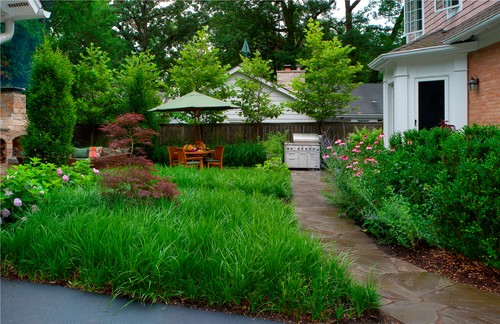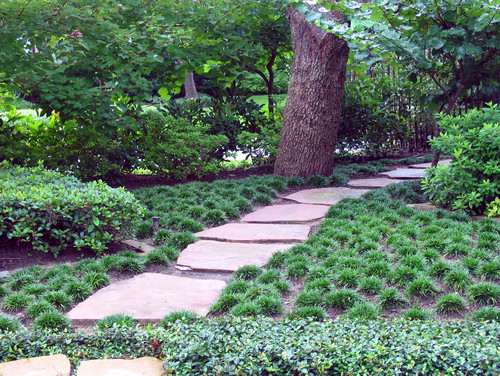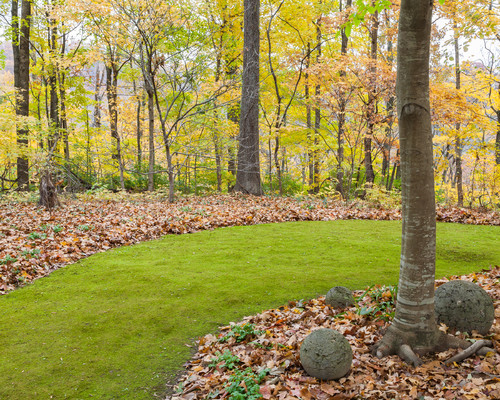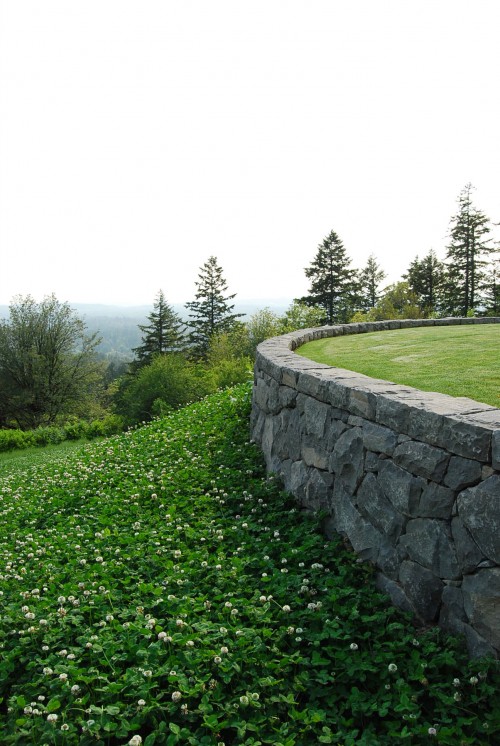Design Dilemma: No-Mow Lawns
In many parts of the country, the day of the lawn has passed. That’s because too many of us are experiencing extreme drought. We can no longer count on unlimited quantities of water to supply our daily needs, much less the needs of our lawn. In other cases, we may have plenty of water, but no time or will to mow each week. And thus, coming into vogue are lawn alternatives. After all, we still want green. We still want pretty. In some cases, we still want a patch of space for the kids to play. And there are several options out there for those who want all that, but not heavy maintenance. Take a look at these ground coverings if you’re looking to ditch the lawnmower:
Sedges.
Sedges are plants with grasslike leaves that grow in clumps. They come in a wide variety of sizes and textures and grow in all types of soils and USDA hardiness zones. The sweet thing about this planting: You can leave a sedge completely unmowed for a taller, more meadow-like look, or break out the mower a few times a year if you want a lawn feeling. Sedges also are a good choice if you have children, since they can handle light foot traffic. For best results, mow your sedge lawn in the spring to remove any winter burn, and let the seeds drop after they have finished flowering to allow for the sedge to fill in more thickly. Plant it in spring or fall, or even in the winter in a very warm climate.
Mondo Grass
Mondo Grass, otherwise known as Ophiopogon japonicus, grows up to 6 inches tall in zones 5 to 9. You can also opt for dwarf mondo grass, which is just 2 inches tall, and never mow again. If you choose regular mondo grass, mow it annually in late winter to keep it filled in and healthy. Mondo Grass, like Sedges, can handle light foot traffic.
Moss
If water isn’t your problem, you might think about moss instead of traditional grass. Moss grows in moist, shady areas and acidic soil. Because it does not grow tall, it completely eliminates the need to mow. It needs no fertilizer and very little water once it’s established, but it does not handle heavy foot traffic well. If you want to walk through it daily, plan to add a flagstone walkway to avoid damaging your lawn. Depending on the variety, moss is adapted to zones 4 to 10. It’s best to plant it in the spring after the last frost and you can count on it taking about a year to fill out.
White Clover
Clover or Trifolium repens, has that very natural, meadow-like look. It is a member of the legume family and grows abundantly in sun to partial shade. A big plus of this plant is that it requires no fertilizer and can survive in a wide range of soils, although it is best adapted to zones 5 to 8. Although it can withstand a bit of foot traffic, it’s not great for those with small children or dogs who are looking for a ground cover that will stand up to playing and running. Sow seeds in the spring after nighttime temperatures are consistently higher than 40 degrees. Keep the soil moist until the clover germinates (sprouts).
Dwarf Myrtle
We all know myrtle but we may not know dwarf myrtle. This plant is a low-growing evergreen shrub that, left to it’s own devices will grow up to 2 feet tall. However, you do have the option to shear down to about one foot. It takes full sun and, once it’s got growing, is drought tolerant. This covering works best for those in milder climates (zones 8 to 9b) and in areas with drought or low-desert regions. It’s got cute little white flowers in the spring, an added bonus, but will not stand up to foot traffic.
As you can see, there’s no need to spend every weekend mowing. With a little research you can come up with a beautiful, practical alternative to your lawn!
Elegant Contemporary on Ibiza from Blacam and Meagher
In the center of the Spanish island of Ibiza, a sublimely proportioned house replete with outdoor arcades and double-height porticos enchants the viewer.
Blacam and Meagher Architects designed it on a completely modular grid, both in plan and in section, juxtaposing cubes and spaces throughout.
This modular grid extends throughout the interior spaces as well, both vertically and horizontally.
The contemporary beauty graces Ibiza’s Morna Valley, a region that in ancient times was terraced for growing crops.
There is an undeniable grandeur matching the vast silence of the surrounding forested hills.
Perfectly proportioned within the portico columns, glass boxes encase a single light bulb.
Because of this elegantly witty touch, the spaces created are sweet and charming, despite the grand proportions.
In fact, the architects were responsible for all the furniture and fittings, including lighting, making for a cohesive experience.
The construction is all of local limestone, using traditional methods, plastering it over concrete blocks.
The luxury property also includes a number of small residential annexes for guests.
Cross ventilation is utilized throughout the basically simple structures, obviating the need for mechanical air conditioning.
Rain water is collected on the flat roof tops and stored in a centralised tank to be recycled, as traditionally done for this kind of payesa.
Outdoor showers complete the sustainable picture in a very delightful retreat.
And its ancient surrounding terraces contained by local stone walls now grow herbs and olives within its garden.
Casa Jondal Celebrates the Good Life on the Magical Island of Ibiza
The surprise of an empty volume is placed to one side of an extremely ceremonial entry staircase reminiscent of an ancient Mayan pyramid.
Once through the grand doorway, you are released into this open glazed living room with custom designed low-slung bamboo-framed seating and tables…
…and overlooking a truly stunning turquoise pool.
A smooth creamy blonde concrete continues inside and out for a seamless flow, and the bamboo is the perfect foil for the turquoise waters.
So the glass box foyer offers a glimpse of the beauties beyond, before continuing on down stairs to the private bedrooms.
The staircases inside also suggest Mayan pyramids, all molded from the same creamy blonde adobe mix.
The floors, the bed platform, the stairs, the levels are shaped from the same material.
Even including a generously proportioned bathtub for two and a contemporary sink in the master bedroom.
The subtle creamy blonde color is perfectly offset by the soft turquoise and the flashing white adobe outside.
The contemporary home subtly incorporates Mayan influences, such as this earthy sculpture laying on its side by the pool.
Another sculpture dominates the entry foyer.
The sumptuous design comes from Jaime Serra of Atlant Del Vent on the sybaritic island of Ibiza in Spain.
Casa Jondal is very special piece of heaven on earth.































